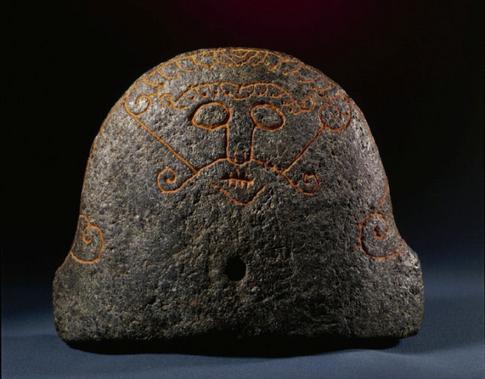



Source: Dorothy Hardy (1909)
The Viking Age was a period of considerable religious change in Scandinavia. Pagan and Christian beliefs existed side by side and religion was an integral part of everyday life. Read through these resources below to learn more about the religious practices and beliefs of the Vikings.
This is a description of how Vikings viewed their world as put into writing by the Viking Snorri Sturluson.
This website looks at the pagan beliefs of the Vikings, and how they began to convert to Christianity.
The Vikings worshipped their gods by sacrificing animals to them. This website describes some of the main sacrifices throughout the year, and the places where Vikings would worship.
Like the Greeks and the Romans before them the Vikings worshipped many gods. This article lists three of the main ones worshipped.
There are nine realms in Norse Mythology, they are called Niflheim, Muspelheim, Asgard, Midgard, Jotunheim, Vanaheim, Alfheim, Svartalfheim, Helheim. The nine worlds in Norse mythology are held in the branches and roots of the world tree Yggdrasil. These realms are the home of different kinds of beings, such as Asgard the home of the Gods and Goddesses, or Jotumheim the home of the giants. This article describes each of the realms; you might recognise a few of them from the Marvel movies!
The Norse gods were organised into two different categories, and this article describes these two categories, and lists some of the major gods and goddesses.
This article describes how Vikings thought the world was created, including the creation of the first humans.
Valhalla (Old Norse: Valhǫll) is the hall of the fallen warriors in Norse mythology. Valhǫll is two compound words, Valr meaning “dead body on a battlefield”, and hǫll meaning hall. This article describes what Valhalla looked like, and how fallen Vikings were chosen to go there in death.
This website has a list of articles that describe various creatures and beliefs in Norse mythology, including giants, elves, and giant wolves.
A Völva was a woman in the Viking age who practiced magic, known as Seidr (in old Norse seiðr), the word Seidr literally means ”to bind”. A Völva often had a very special role within the society and would often have close ties with the leaders of her clan. You could call a Völva/Vǫlva a spiritual leader or healer in the Nordic society. A man could also practice Seidr, and he would be known as a Seer, but that was very rare.
Among the Germanic and Viking peoples, sacred space consisted of natural, powerful features of the wild landscape, as well as being created using physical markers to delineate the space, to create a frið-garðr, a zone of peace. This type of sacred space was used in religious worship, but also in law courts, and surprisingly enough to create boundaries for duels as well. This article investigates the nature and uses of sacred space in the Viking world.
The Vikings’ belief in the Norse gods was of significance to almost all activities – in everyday life or for warriors in battle. They therefore sacrificed to the gods to obtain their goodwill. In recent decades dramatic finds have shown that large religious sacrifices in honour of the gods were held at magnates’ residences. Christianity was a potent force throughout the Viking period and by the 800s part of the population was already Christian. The first churches also appeared at this time. Kings and magnates erected the first buildings in honour of the new god. But why was the old Nordic religion replaced by Christianity? In addition, why did some Vikings never completely abandon Odin, Thor and the other old gods in favour of Christ?


The orb of the world, which mankind inhabits, is riveted by many fjords, so that great seas run into the land from the Outer Ocean. Thus, it is known that a great sea goes in through NORVASUND (Straits of Gibraltar) all the way to the land of Jerusalem. From that same sea a long bight stretches towards the north-east, called the Black Sea, which divides the three continents of the earth: to the east lies Asia, to the west lies Europe, but to the north of the Black Sea Greater Sweden or Sweden the Cold (Russia)
Through Greater Sweden (Russia) from the range of mountains that lie to the north beyond the edge of human habitation, there runs a river properly called the Tanais (Don), which flows into the Black Sea. In Asia to the east of the TANAIS there was a land called Asaland or Asaheim (land of the Ęsir); its chief city was called Asgard (Home of the Ęsir). The city was ruled by a chieftain called Odin and it was a great centre for sacrifices...

This excerpt from a picture stone is interpreted as a blót to Odin. In the middle, a person appears to be sacrificed on an altar. Above hovers a large bird of prey, possibly one of Odin's ravens. To the left of the picture is a person with a rope around his neck hanging in a tree.

On a stone at Hørdum Church, 20km southwest of Thisted, you can see a depiction of Thor’s attempt to fish for the World Serpent. The legend is carved as a drawing into to the stone in which Thor is depicted in his boat trying to pull the serpent aboard. The stone was used as a stair step until it was discovered during renovations at the church i 1954.

On the picture stone from Snaptun, Loki is seen with his mouth sewn together. Loki had bet his head in a bet with the dwarf Brokk. When Loki lost, he saved his life by saying that Brokk was only allowed to take his head and not something off his neck. As punishment for breaking the promise, the gods allowed the dwarf to close Loki's mouth - with a needle and thread.

A stone hogback grave marker from St Alkmund’s Church, Derby. The site of St Alkmund’s Church is thought to have been on one of the oldest Christian sites in the area. Excavations on the site have shown that the church was in existence before the ninth century and that the presence of the Great Army in the ninth century seems to have led to a period of neglect and decay, before it was restored following the reconquest of the Danelaw in the tenth century or early eleventh century.
Only about half of this hogback grave cover survives. It has the typical bear at the gable end, although the carving is damaged, and an interlaced serpent design within the panels on the side. It is typical of this type of grave cover which is found throughout northern England and into Scotland. They occur in Viking-dominated areas of the country, and appear to be an Anglo-Scandinavian tradition combining elements of pre-Christian and Christian iconography.

These may have been worn to show devotion to the god Thor, or to secure the god’s protection, although there is little evidence to support this interpretation. Pendants like this have been found made of lead, copper alloy, silver and gold, as well as other materials, showing that many different strata of society could have worn them.

The Poetic Edda is the modern name for an untitled collection of Old Norse anonymous poems, which is distinct from the Prose Edda written by Snorri Sturluson. Several versions exist, all primarily of text from the Icelandic medieval manuscript known as the Codex Regius, which contains 31 poems.

The Prose Edda, also known as the Younger Edda, Snorri's Edda (Icelandic: Snorra Edda) or, historically, simply as Edda, is an Old Norse textbook written in Iceland during the early 13th century. The work is often assumed to have been to some extent written, or at least compiled, by the Icelandic scholar, lawspeaker, and historian Snorri Sturluson c. 1220. It is considered the fullest and most detailed source for modern knowledge of Norse mythology, the body of myths of the North Germanic peoples, and draws from a wide variety of sources, including versions of poems that survive into today in a collection known as the Poetic Edda.


 An introduction to Viking mythology
by
An introduction to Viking mythology
by
 Gods and goddesses of Vikings and Northlands
by
Gods and goddesses of Vikings and Northlands
by
 Vikings : the battle at the end of time
by
Vikings : the battle at the end of time
by